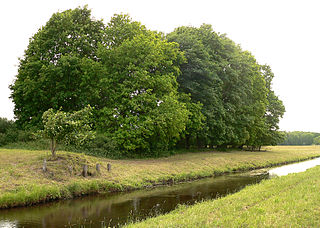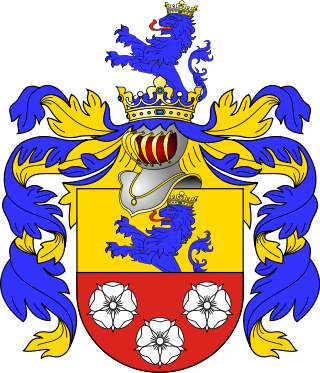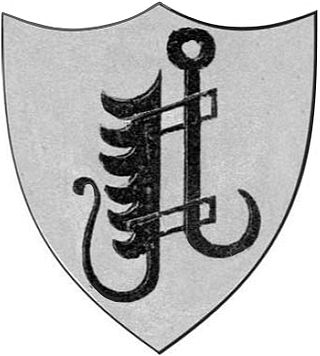
Hodenberg is the name of an old Lower Saxon noble family. The originally hochfrei family line belonged to the fourth military feudal level or Heerschild .

Hodenberg is the name of an old Lower Saxon noble family. The originally hochfrei family line belonged to the fourth military feudal level or Heerschild .

Since early times the von Hodenberg lords were protectors (Schirmvögte) of the monastery at Bücken founded by Archbishop Rembert of Bremen. Their name was probably derived from this hereditary office, because in Low German the word Hode means Hut or Schirm (i.e. protection or shield). At one time Hodenberg Castle on the Weser, the oldest ancestral seat of the family, was situated in the vicinity of this monastery.
The oldest known progenitor was Hermann Hode, who was mentioned in 1149 in a deed by the Archbishop of Bremen, Hartwig I of Stade. Somewhat later another Hermann Hode appeared who, from 1168, was frequently named amongst the followers of Henry the Lion. The construction of Hoya Castle, not far from Hodenberg, built by the ambitious counts of Hoya, caused the Hodenberg lords to build Hodenhagen Castle near Hodenhagen east of the Weser in the first half of the 13th century. A descendant was named after it in 1244 dei gratia nobilis de Hodenhagen ("by the grace of God, nobleman of Hodenhagen"). In 1291 this son, Heinrich, Edelherr von Hodenhagen (Henry, Baron of Hodenhagen), sold Hodenberg Castle with all its estate west of the Weser and all its inhabitants to the counts of Hoya, who shortly afterwards also captured the estate of the Vogtei of Bücken. In 1313 Heinrich's sons, Hermann and Heinrich, also sold their own land east of the Weser, so that the counts of Hoya took possession of the entire Hodenberg estate.
Both brothers continued to call themselves Edelherren (barons), but married wives of lower noble status, so that their descendants lost their status as peers. From the 16th century two main family lines arose whose last common ancestor was Marquard III von Hodenberg (died 1538). In 1622 Emperor Ferdinand II gave the Marquard von Hodenberg and his family leave to be called the Edler (lord) von Hodenberg, a title which the line made no use of however. In 1859 George V of Hanover recognised the family as a barony.
The coat of arms displays a red wing on a silver shield, whose wing feathers curve downwards, and which is decorated with a golden stalked trefoil. The helmet is surmounted by a wing whose wing feathers curve round to the left. The mantling is red and silver.
Nienburg is a district (Landkreis) in Lower Saxony, Germany. It is bounded by the districts of Diepholz, Verden, Heidekreis, Hanover and Schaumburg, and by the state of North Rhine-Westphalia.

Nienburg is a town and capital of the district Nienburg, in Lower Saxony, Germany.

The County of Hoya was a state of the Holy Roman Empire, located in the present German state of Lower Saxony. It was centered on the town of Hoya on the middle Weser river, between Bremen and Nienburg; the area now belongs to the districts of Nienburg and Diepholz. The largest city of the county was Nienburg.

Jens Grand, the Firebug was a Danish archbishop of Lund (1289–1302), titular Archbishop of Riga and Terra Mariana (1304–1310), and Prince-Archbishop of Bremen, known as the central figure of the second ecclesiastical struggle in Denmark in the late 13th century. He was an outstanding jurist of canon law.
The Stade Region emerged in 1823 by an administrative reorganisation of the dominions of the Kingdom of Hanover, a sovereign state, whose then territory is almost completely part of today's German federal state of Lower Saxony. Until 1837 the Kingdom of Hanover was ruled in personal union by the Kings of the United Kingdom of Great Britain and Ireland.
Albert II of Brunswick-Wolfenbüttel was Prince-Archbishop of Bremen in the years 1361–1395.

Hodenhagen Castle is the site of a former lowland castle (Niederungsburg) built in the 13th century in the vicinity of Hodenhagen in the German state of Lower Saxony. This medieval manor house only lasted just under 100 years and was destroyed in 1289.

The House of Henckel von Donnersmarck is an old Austro-German noble family that originated in the former region of Spiš in Upper Hungary, now in Slovakia. The founder of the family was Henckel de Quintoforo in the 14/15th century. The original seat of the family was in Donnersmarck.
Johann Rode von Wale was a Catholic cleric, a Doctor of Canon and Civil Law, a chronicler, a long-serving government official (1468–1497) and as John III Prince-archbishop of Bremen between 1497 and 1511.

Henry of Saxe-Lauenburg was a Prince-Archbishop of Bremen, then Prince-Bishop of Osnabrück, then Prince-Bishop of Paderborn.

The House of Alvensleben is an ancient, Low German (niederdeutsch) noble family from the Altmark region, whose earliest known member, Wichard de Alvensleve, is first mentioned in 1163 as a ministerialis of the Bishopric of Halberstadt. The family name derives from Alvensleben Castle. They are one of the oldest extant German aristocratic families.

The House von der Decken is the name of an old Hanoverian family of German nobility. Since more than 750 years the center of the family is in a part of Lower Saxony at the south bank of the river Elbe called Kehdingen.

Brandis Castle or Maienfeld Castle is a castle in the municipality of Maienfeld of the Canton of Graubünden in Switzerland. It is a Swiss heritage site of national significance.

John V, Count of Oldenburg and Delmenhorst was a member of the House of Oldenburg. He was the ruling Count of Oldenburg from 1500 to 1526. His parents were Gerhard VI, Count of Oldenburg and Adelheid of Tecklenburg.
Count Jobst II of Hoya ruled the County of Hoya from 1511 until his death.
Eric I, Count of Hoya (1370-1426) was a German nobleman. He was the ruling Count of Upper Hoya from 1377 until his death.

The House of Asseburg, original German name von der Asseburg, is an old Lower Saxon aristocratic family which had its origin in Wolfenbüttel and Asseburg. During the 12th and 13th centuries the lords of Wolfenbüttel were able to establish their own small county, but were soon forced to give way to the Brunswick dukes of the House of Welf. Later their title was taken over by other families in the female line, and the counts of Asseburg continue to be landowners to this day.

Merveldt is the name of a Westphalian noble family, which belongs to the nobility of the Middle Ages. The Herrn [Lords] von Merveldt were among the oldest families in the Münsterland. Merfeld, the eponymous seat of the family, is now a neighborhood of the city of Dülmen in the District of Coesfeld in the state of North Rhine-Westphalia in Germany.
Bodo von Hodenberg was a German regional administrator and poet.

The House von der Osten [ ˈoːstən ] is an ancient and distinguished aristocratic family from Pomerania that has been established in Pomerania since 1248, originally from Stift Bremen. The family's ancestral home is in Lower Saxony, near the Oste River. The family acquired numerous properties in Western and Eastern Pomerania, becoming one of the largest landowners in Pomerania. In 1854, the von der Ostens were one of the first ten families to hold the hereditary right of presentation to the Prussian House of Lords.